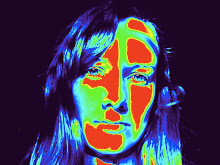I was looking at one of my favorite websites today called Polar Inertia Journal, a photographic essay journal with esoteric photos of rare places. One of the essays was on the toy district in Los Angeles, which I happened to spend an entire day exploring once as I was filming for a man working on a Transformers Fans documentary.
James Bucknam, the writer/photographer of the photo essay, sees in the toy district a quiet stillness and a place of peace. He remarks on its pureness, its spatial moments, and its chaos and randomness. He shows a different side of the toy district as literally no toy nor anything donning a brilliant color appears in his photos save some siding on a truck and some shooting targets. The chaos and overwhelming mixture of plastic and cheap Chinese imports never make a debut in his Polaroids. He chooses to photograph bare walls and empty streets. I am wondering why this is.
Because in his last explanatory paragraph,
the essayist has this to say,
"The Toy District is a vivid case study into LA’s psyche and social construct. It is a collective of spatial moments with no emphasis on the whole, or the end result. It forces you to recognize that Los Angeles, in contemporary reality, is a vast rural wasteland of human confusion. LA is a collection of juvenile cities and districts, and we have much to learn."
(James Bucknam, polar inertia journal.)
The spatial moments he portrays through his photography ceaselessly reflect a bare wasteland where nothing resembling toys or selling exists. But the 'human confusion' and the 'collection of juvenile cities', where are they? To encounter the juvenile and the confusion which is actually just people trying to live better, one must cross to the other side of the stucco wall, underneath the foggy, plastic tarps, inside the brushed metal doors. There you will find humans and the players of the confusion. Their faces and movements are the psyche and the social construct. I think a look into their lives would better serve an analysis of the area. Or at least to place them next to the bare cement. We are constantly being thrown at the cement or across it, like marbles across asphalt.
I resonate with the observation of the lack of emphasis on the whole. When I visited the toy district, rain came from a grey sky off and on all day. We were cold and afraid of the camera getting wet at all times. And we were constantly on the move, hopping around chunky cement and then pouring into lopsided plastic aisles in search of just the right toy... is that it? No that's a fake... that one? nope. It was an endless search for a recognizable object in lakes upon seas of treasures.
Though the stores are connected, much like most shopping malls, it's every store for itself, so owners must employ tactics to entice you into the store. They are hoping that you will find that one recognizable object as well and that it would be at their stand. Though perhaps the people in the stalls have relationships, many buyers sail through from another world, like spiderwebs being blown together by the same breeze.
But this maze of colors is created in such a small space because that is what has been given. Los Angeles, yes, does have a lot to learn, but we have a lot to learn from it. Is it only the wind and the internet that wraps up our cobwebs and will we always continue to take pictures of blank walls?
Friday, November 9, 2007
the toy district
Posted by
ariel
at
Friday, November 09, 2007
![]()
Subscribe to:
Post Comments (Atom)

No comments:
Post a Comment